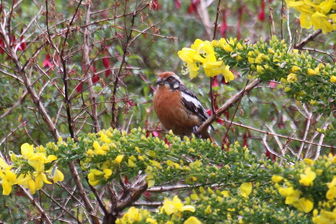Rufous-tailed Plantcutter
It is a stocky bird, 18-20 centimetres in length, with short wings and a red eye. The longish tail is black with a reddish base. The upperparts of the male are grey-brown with dark streaks while the crown and underparts are chestnut-coloured. There is a white bar on the wing and a pattern of dark and pale areas on the face. Females have buff underparts with brown streaks and have buff rather than white in the wings. They do not have the males' chestnut crown but may show a cinnamon wash to the forehead and throat. The song is a series of stuttering notes followed by a rasping trill similar to a fishing reel.

Original source: dfaulderPermission(Reusing this file)This image, which was originally posted to Flickr.com, was uploaded to Commons using Flickr upload bot on 03:59, 18 March 2010 (UTC) by Rufous-crowned Sparrow (talk). On that date it was licensed under the license below.This file is licensed under the Creative Commons Attribution 2.0 Generic license.You are free:to share – to copy, distribute and transmit the work
Author: dfaulderPermission(Reusing this file)This image, which was originally posted to Flickr.com, was uploaded to Commons using Flickr upload bot on 03:59, 18 March 2010 (UTC) by Rufous-crowned Sparrow (talk). On that date it was licensed under the license below.This file is licensed under the Creative Commons Attribution 2.0 Generic license.You are free:to share – to copy, distribute and transmit the work
The Rufous-tailed Plantcutter is classified as Least Concern. Does not qualify for a more at risk category. Widespread and abundant taxa are included in this category.
The Rufous-tailed Plantcutter is found further south than any other cotinga, inhabiting scrub, forest edge and river valleys in Chile and western Argentina. The range extends from Magallanes region north to Atacama in Chile and from Santa Cruz north to Mendoza in Argentina. Birds breeding in southern or high-altitude regions move northwards or towards the lowlands in winter. It has been recorded as a vagrant to the Falkland Islands. More
Rufous-tailed plantcutters have developed an affinity for cereal leaves, among them wheat and oat. Reproductive biology Little is known about reproduction in the Phytotomidae, mostly due to a lack of field studies. The birds build loose nests, and the females lay up to four eggs. Conservation status One species, the Peruvian plantcutter, is Endangered due to loss of numbers and habitat. The other species are more widespread and are not threatened. More
The rufous-tailed plantcutter can be a nuisance to farmers because of its fondness for cereal leaves. Home of Wiki & Reference Answers, the world’s leading Q&A siteReference AnswersEnglish▼English▼ Deutsch Español Français Italiano Tagalog * * Search unanswered questions... * Browse: Unanswered questions | Most-recent questions | Reference library Enter a question here... More
Images Male rufous-tailed plantcutter perched on a branch Although bulky for its size, the rufous-tailed plantcutter is actually one of the world’s smallest herbivorous bird species. Attractively patterned in various shades of grey, black and rufous, its upperparts are broadly streaked blackish-brown with a ... More
Male rufous-tailed plantcutter perched on a branch Male rufous-tailed plantcutter perched on a branchPrint factsheet Facts - Kingdom Animalia Phylum Chordata Class Aves Order Passeriformes Family Cotingidae Genus Phytotoma (1) Size Length: 18 - 20 cm (2) More
The Rufous-tailed Plantcutter is a fairly small passerine bird of southern South America, now placed in the cotinga family. It is a stocky bird, 18-20 centimetres in length, with short wings and a red eye. The longish tail is black with a reddish base. The upperparts of the male are grey-brown with dark streaks while the crown and underparts are chestnut-coloured. There is a white bar on the wing and a pattern of dark and pale areas on the face. More
